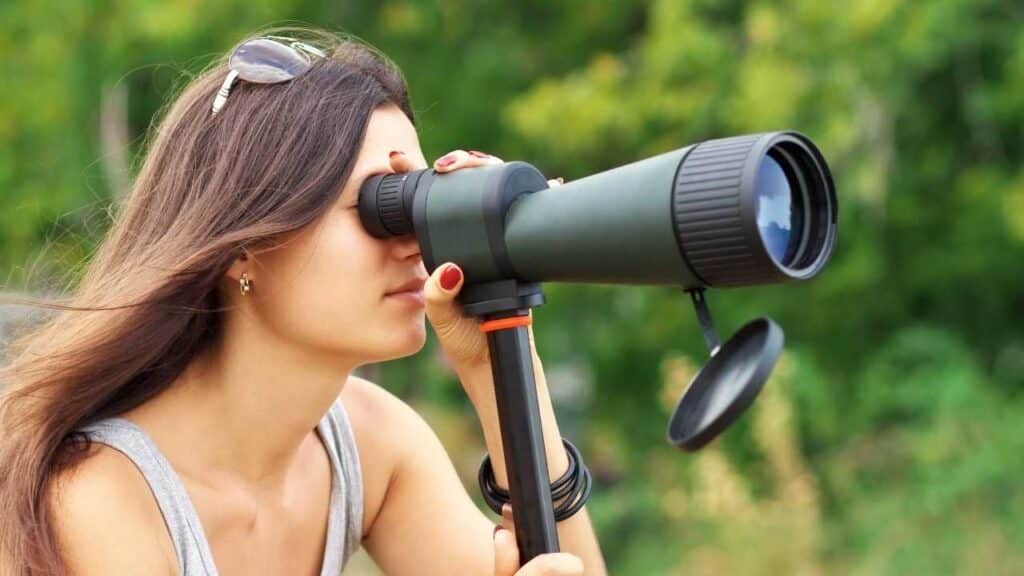
As its name suggests, a spotting scope is used to spot objects. The usage of a spotting scope is not restricted to any one purpose. It is used for both land and sea viewing. It can be used for several different purposes. It will help you to see details that are not possible to be seen with the naked eye. Spotting scopes are available in a variety of different sizes. The different numbers on a spotting scope represent the difference in their magnification.
The spotting scope is a portable device, sometimes confused with a binocular. But it is different from a binocular as it is generally higher in power than binoculars.
In the initial stages of hunting or birding, it is feasible to use binoculars. They are lightweight, more compact, and hence easy to carry around. But as you get more into these outdoor activities, sooner or later, you will need a spotting scope.
In hunting, spotting scope is helpful as it allows you to spot and hit the target.
More magnification of a spotting scope means that the scope allows seeing more details. This creates an ideal situation for birding and hunting. A bigger lens will capture more light, resulting in a clearer image, wider field of view, more weight, more expensive. A large lens means more weight of the spotting scope.
While choosing a spotting scope, there are a lot of essential features to consider. The scope you will pick depends on what you need to do with the lens.
If you have to stay at one location and do not move a lot, a heavier scope will not be a problem. But if you need to move, then a 50mm scope will be most suitable.
How does a spotting scope work?
Spotting scopes and binoculars are often considered to be used interchangeably, but both have a variety of differences. For understanding the working of a spotting scope, it is essential to understand its structure. A spotting scope consists of a singular eyepiece, unlike a pair of binoculars that has two eyepieces. It consists of a long, single tube. At the front of the tube is the optical lens. The lens of this diameter decides the magnification of the spotting scope. This lens is covered with a lens shade that protects the vision from getting affected by sunlight. At the back of the tube, there is an eyepiece or the ocular lens. The ocular lens has an eyecup. The eyecup can be rolled up and down. There is a range of magnification on most spotting scopes, and the magnification wheel present can adjust it on the tube. Then, in the middle of the tube is the focus wheel that helps to adjust the focus of the view.
Adjust your spotting scope on a tripod. Make sure that the adjustment is proper and the tripod is stable. The eyepiece should be in front of your eye. You can watch it from a distance also if you wear glasses. This is because a spotting scope gives eye relief. Now, you can adjust the magnification and decide what magnification you want for viewing your target. After this, adjust your focus with the help of the focus wheel to get a clearer image of the field of view. Use the sunshade to avoid bright sunlight by simply pulling it out.
Features of a Spotting Scope
People who use a spotting scope need to know some essential features of a scope. Here is a list of important features of a spotting scope.
Higher magnification
For understanding this feature, it is important to know how magnification works. Magnification is important to have a clear image of distant objects. It works for hunting, birding, and all other such activities. As compared to binoculars, the magnification of a spotting scope is higher. More magnification allows a clear view of distant objects. It also allows you to view a clear image in zoom mode.
Objective lens
A good-quality objective lens is needed for viewing images. Also, a larger objective lens allows viewing distant objects in detail. The objective lens of a spotting scope is more significant than a binocular. Usually, the size of the spotting scope lenses ranges from 50mm to 80mm. Along with distant objects, a spotting scope also helps in viewing objects when the light is low.
Eye Relief
To understand this feature, it is important to understand what eye relief is. It is the distance of your eye to the scope. Eye relief is a quality of the reasonable scope. It is important for people who need to wear glasses. A spotting scope of 14mm and over gives eye relief.
Weatherproof
Spotting scopes are primarily used for outdoor activities; hence many of them are waterproof and fog proof. They can also deal with ruggedness and are utilized in harsh conditions.
A Spotting Scope needs a tripod
A spotting scope is higher in magnification and bigger in size. Because of this, it needs stable support provided by a tripod.
Difference between Spotting scope and Binoculars
Most people think that binoculars and a spotting scope are used interchangeably. Both of these are used for some similar purposes but are different in many ways.
- A binocular allows the use of both eyes, while a spotting scope can be used only with one eye.
- Spotting scopes are higher in magnification as compared to binoculars. Generally, the magnification of a spotting scope is 60X, which means that an object appears to be 60 times bigger than its original size through a spotting scope. And the magnification of most binoculars is 1X to 12X.
The use of a tripod
A spotting scope and tripod almost always go together. Spotting scope requires a stable base for its functioning as spotting scopes need to spot objects and get a clear target image. Thus, for utilizing the maximum potential of a scope, a tripod is necessary.
FAQS
What do the numbers on a spotting scope represent?
The two sets of numbers on a spotting scope represent two different things. The first represents the magnification and the second one represents the diameter.
What is the maximum magnification of a spotting scope?
The maximum magnification a spotting scope can have is 15x to 60x.
How to adjust the magnification of a spotting scope?
Most spotting scopes are manually adjustable. They provide a range of magnification options. The range is usually between 15-45x or 20-60x.
Can a spotting scope use without a tripod?
Tripod gives stable support to a spotting scope. A solid base such as a table also is used in place of a tripod.
